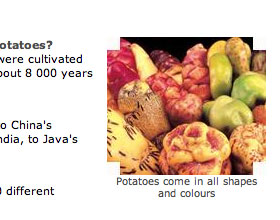This story is not particularly agricultural, but I couldn’t resist it. Brazilian researchers extracted the essential oils from a Piper sp commonly eaten by bats and then smeared the stuff on plastic fruits, which they then distributed in areas of damaged rainforest. The bats were attracted to the fake fruits, though they wouldn’t normally fly in degraded forest. Why go to all this trouble? Because the bats spread lots of seeds via their faeces, and could thus be used to restore the vegetation.
Too delicious
Q: When is potato diversity not potato diversity?
A: When it is in the hands of assorted experts.
 I hate to be pedantic here. (Actually, that’s a terrible lie; I love to be pedantic, especially about crops and food.) But if you look closely at the photograph, and you know your tubers, you’ll know that those aren’t potatoes in the picture. They are oca and mashua. Andean tubers, to be sure, but not potatoes. So who made this elemental error? None other than the good folks at the International Year of the Potato.
I hate to be pedantic here. (Actually, that’s a terrible lie; I love to be pedantic, especially about crops and food.) But if you look closely at the photograph, and you know your tubers, you’ll know that those aren’t potatoes in the picture. They are oca and mashua. Andean tubers, to be sure, but not potatoes. So who made this elemental error? None other than the good folks at the International Year of the Potato.
Worse, it’s on the page specifically addressed “Hey, kids!” (Lord how I love that exciting exclamation mark.) One could, of course, argue that the caption just happens to be underneath a photo of other Andean tubers. But that won’t wash. What we have here is a total and abject failure to know anything whatsoever about potatoes. How can kids! trust anything else on the page?
I’m sure that the International Year of the Potato will be a good thing, just as the International Year of Rice was a good thing. I’m equally sure someone will eventually detect this egregious and appalling error. In the meantime, just to be on the safe side, I snapped the page and am preserving it here for posterity.
And hey, potato people, my rates remain reasonable.
Using biodiversity collections
Researchers have estimated rates of reproduction and survival for the marbled murrelet by “comparing the ratios of birds in different age groups using 170 specimens collected between 1892 and 1922 housed in the collections of the California Academy of Sciences and the UC Berkeley Museum of Vertebrate Zoology … with values predicted from comparison with other bird species, and with contemporary rates obtained from murrelets they captured at sea and from their mark-recapture studies.” The results suggested that birth rates were almost 10 times higher for this endangered seabird 100 years ago than they are today. Read all about it here. That’s a very creative use of a biodiversity collection to explain the recent decline in numbers of this species, and its conservation status. Has something similar been done with herbarium and/or plant genebank collections? I can’t think of any examples, but they must be out there…
Bee shortage looms
Things don’t seem to be getting any easier for the fruit and vegetable farmers of the US, with a continuing shortage of bees. The number of commercial colonies in the US has halved over the past 25 years, according to the report. And that could show up in the price of almonds. I had no idea that the state of California supplies 80% of the world market for almonds.
Housekeeping help needed
A couple of people have reported problems with the comment system here. As it happens, both had Hotmail accounts, and messages from Hotmail were being bounced. I have no way of knowing whether this is a problem with the blog software or with Hotmail itself (and I am not about to sign up for Hotmail just to see). So, if you have a Hotmail account — or any insight into the problem — could you please try and share that information by leaving a comment to this post?
If that doesn’t work for you, please use to Contact Us link about to tell us what happened.
Thanks
The Management
p.s. Later … I wonder if it is anything to do with this hacker attack yesterday?